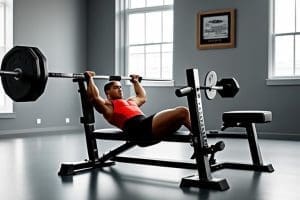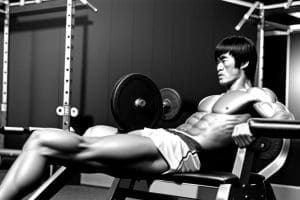Weight benches stand as stalwart allies in the realm of fitness, offering a dynamic platform for strength training and muscle development. This comprehensive guide aims to unravel the nuances of weight benches, exploring their types, benefits, selection criteria, safety considerations, and a plethora of exercises that can be performed on these versatile pieces of equipment.
Types of Weight Benches
Weight benches stand as foundational pillars in the world of strength training, offering diverse options tailored to individual fitness needs. Let’s delve into the intricacies of various types, each catering to unique workout preferences.
- Flat Weight Benches:Flat benches form the bedrock of strength training, presenting a steadfast and level surface. Ideal for fundamental exercises like bench presses, rows, and core workouts, they provide stability for users of all levels.
Versatile Foundation: Flat weight benches act as a versatile foundation for beginners and seasoned lifters alike, supporting an array of foundational exercises that foster overall strength development.
- Adjustable Weight Benches: Embracing adaptability, adjustable benches elevate workout experiences by featuring modifiable backrests. Users can effortlessly alter the bench’s angle, transitioning between incline, decline, and flat positions to accommodate a diverse range of exercises.
Dynamic Flexibility: The dynamic flexibility offered by adjustable weight benches empowers users to engage in a spectrum of exercises targeting various muscle groups. This adaptability is crucial for those seeking a comprehensive workout routine.
- Olympic Weight Benches: Engineered for heavy-duty performance, Olympic benches stand as robust platforms designed to accommodate Olympic-sized barbells. These benches often boast additional features like plate storage and leg attachments, providing advanced options for users pursuing intense strength training.
Advanced Options: Olympic weight benches cater to advanced weightlifters seeking additional challenges. With built-in features facilitating the use of Olympic-sized barbells and specialized attachments, users can engage in rigorous workouts, pushing their limits.
- Weight Bench with Leg Extension: Expanding the spectrum, weight benches with leg extensions introduce targeted exercises for the lower body. The incorporation of leg extensions enables users to focus on quadriceps and leg muscle development, enhancing the overall balance of their strength training routine.
Lower Body Emphasis: These benches with leg extensions provide a dedicated space for lower body workouts, addressing the specific needs of individuals aiming to strengthen their legs and achieve a well-rounded physique.
- Weight Bench with Weights: Simplifying the setup, weight benches with included weights offer a comprehensive solution for users looking for a complete package. With pre-included weights, these benches streamline the process, making it convenient for users to initiate their strength training journey.
Ready-Made Package: The inclusion of weights with the bench provides a turnkey solution for those starting their fitness journey. It eliminates the need for separate weight procurement, offering a convenient and efficient setup.
- Weight Bench and Squat Rack: Combining functionalities, weight benches with integrated squat racks offer an all-in-one solution for users seeking versatility. These benches seamlessly integrate squat racks, expanding workout possibilities and accommodating a broader range of exercises.
Versatility Amplified: The integration of squat racks enhances the versatility of these benches, allowing users to perform a myriad of exercises that encompass both upper and lower body muscle groups.
- Commercial Weight Bench: Engineered for durability and high-performance, commercial weight benches are designed to withstand the demands of busy fitness environments. These benches, often found in commercial gyms, prioritize sturdiness and reliability to cater to a wide range of users.
Built for Intensive Use: Commercial weight benches are crafted with heavy-duty materials, ensuring longevity and stability. Their robust construction makes them suitable for environments where multiple users engage in intensive workouts daily.
- FID (Flat/Incline/Decline) Weight Benches: Integrating multiple functionalities, FID weight benches offer a versatile workout experience by allowing users to adjust the bench’s angle. This versatility caters to a wide range of exercises, including flat, incline, decline, and variations in between.
Dynamic Adjustability: FID weight benches provide dynamic adjustability, allowing users to customize the bench’s position for different exercises. This adaptability enhances the overall versatility of these benches, enabling a comprehensive workout targeting various muscle groups.
Understanding the diverse landscape of weight benches empowers fitness enthusiasts to make informed choices aligned with their specific goals. Whether seeking a solid foundation for foundational exercises, advanced options for Olympic lifting, or comprehensive solutions with integrated features, the world of weight benches offers a plethora of choices to suit individual preferences.

Which Weight Bench Is Best
Benefits of Using a Weight Bench
The utilization of weight benches in strength training programs introduces a spectrum of benefits that cater to various fitness goals and preferences. Let’s delve into the advantages that make weight benches a fundamental asset in any fitness routine.
- Versatility: Weight benches serve as versatile fitness hubs, accommodating an extensive array of exercises that target diverse muscle groups. From classic bench presses to inclined and declined movements, the versatility of weight benches empowers users to craft comprehensive workout routines.
Expansive Exercise Repertoire: The expansive exercise repertoire facilitated by weight benches ensures that users can engage in a broad spectrum of movements, fostering a well-rounded approach to strength training.
- Stability: Stability is paramount in weightlifting, and weight benches provide a stable platform essential for secure positioning during lifts. This stability significantly reduces the risk of injury, allowing users to focus on proper form and controlled movements.
Safe Lifting Environment: The stable foundation offered by weight benches creates a safe lifting environment, providing users with the confidence to push their limits without compromising safety.
- Muscle Isolation: Weight benches contribute to effective muscle isolation, enabling users to target specific muscle groups with precision. Isolating muscles during exercises allows for concentrated strength development in particular areas, fostering balanced and targeted growth.
Targeted Strength Development: Whether focusing on chest, shoulders, or arms, the ability to isolate muscles on a weight bench facilitates targeted strength development, helping users achieve their specific fitness objectives.
- Progressive Resistance: Adjustable weight benches play a pivotal role in promoting progressive resistance. Users can easily modify the angle of the bench, increasing or decreasing resistance levels. This adaptability ensures a progressive approach to strength training, essential for continuous gains.
Continuous Strength Gains: The capacity for progressive resistance on adjustable benches aligns with the principle of progressive overload, a key factor in sustained strength gains over time.
- Home Gym Convenience: Weight benches offer unparalleled convenience for home gyms, presenting a compact and versatile solution for strength training. Their space-efficient design makes them accessible to individuals establishing home workout spaces.
Accessible Workout Options: Home gym enthusiasts benefit from the convenience of weight benches, unlocking a multitude of workout options within the confines of their personal fitness sanctuaries.
Embracing the versatility, stability, muscle isolation capabilities, progressive resistance, and home gym convenience, weight benches emerge as indispensable tools in the pursuit of strength, fitness, and overall well-being. Their multifaceted advantages cater to users at various fitness levels, making them a cornerstone of effective and dynamic strength training regimens.

Which is the best type of weight bench
How to Choose the Right Weight Bench for Your Needs
Selecting the appropriate weight bench is a crucial step in optimizing your strength training regimen. Let’s delve into the key factors to consider, providing detailed insights for each aspect:
- Type of Exercises: When choosing a weight bench, the first consideration is the range of exercises you plan to perform. A bench should seamlessly accommodate the movements that align with your workout routine. Whether it’s bench presses, rows, or core exercises, ensure the bench is tailored to your specific needs.
- Adjustability: The versatility offered by adjustable benches is unparalleled. Evaluate the adjustability features, allowing you to modify the bench’s angle to suit various exercises. Determine the range of angles required for your workouts, ensuring the bench’s flexibility aligns with your preferred positions.
- Weight Capacity: Safety is paramount in strength training. Confirm that the weight bench has a capacity that exceeds your maximum lifting potential. This precaution ensures the bench can handle the load, providing stability and security during your lifts.
- Stability and Durability: Sturdy frames and robust construction are pivotal in guaranteeing stability and longevity. Look for weight benches that prioritize durability, as this not only enhances your workout experience but also ensures the bench’s endurance over time.
- Additional Features: Explore the additional features that weight benches may offer. Features like leg extensions, preacher curls, and attachments can add significant value, facilitating specific exercises and contributing to a more comprehensive workout experience.

What weight bench is good for your style of workout
Safety Tips for Using a Weight Bench:
Ensuring safety during your weight bench workouts is essential. Here are detailed safety tips to incorporate into your routine:
- Warm-Up Adequately: Begin your workout with a thorough warm-up. Engaging in dynamic stretches and light exercises prepares your muscles and joints for the intensity of your lifting session.
- Proper Form: Maintain proper form during exercises. Correct posture not only optimizes the effectiveness of your workout but also minimizes the risk of strain or injury.
- Spotter for Heavy Lifts: For heavier lifts, enlist a spotter. A spotter provides assistance when needed, ensuring safety and offering support during challenging sets.
- Secure Footing: Before initiating your lifts, confirm stable footing on the floor. Proper footing prevents slips and enhances overall stability during your workout.
- Gradual Progression: Progressively increase weights to allow your body to adapt. Gradual progression reduces the risk of overexertion, promoting a safer and more sustainable strength training journey.
By meticulously considering these factors and integrating safety measures into your routine, you can confidently select the right weight bench and embark on a safe, effective, and rewarding strength training experience.

Best weight bench for muscle gain
Common Exercises with Weight Benches
Unlocking the full potential of weight benches involves incorporating a variety of exercises that target distinct muscle groups. Let’s delve into an extensive list of common exercises, exploring their benefits and the specific muscles they engage:
- Flat Bench Press: A classic foundational exercise, the flat bench press is a powerhouse for developing the chest, triceps, and shoulders. It engages multiple muscle groups simultaneously, promoting overall upper body strength.
- Incline Bench Press: Elevating the bench transforms the dynamics, emphasizing the upper chest muscles. The incline bench press is instrumental in sculpting a well-rounded and defined chest, focusing on the clavicular head of the pectoralis major.
- Decline Bench Press: Conversely, the decline bench press shifts the focus to the lower chest muscles. This variation ensures comprehensive chest development, targeting the sternal head of the pectoralis major.
- Bent-Over Rows: Engaging the back muscles, bent-over rows are vital for building strength and development in the latissimus dorsi, rhomboids, and middle trapezius. This exercise contributes to a well-defined and robust back.
- Seated Shoulder Press: Isolating the deltoids, the seated shoulder press is key for shoulder strength and development. This exercise enhances shoulder stability and contributes to a sculpted and well-proportioned upper body.
- Leg Extensions: Transitioning to lower body development, leg extensions isolate the quadriceps. This exercise is essential for toning and strengthening the front thigh muscles, promoting balanced lower body development.
- Abdominal Crunches: Shifting the focus to core strength, abdominal crunches target the rectus abdominis and obliques. This foundational core exercise contributes to overall abdominal strength, stability, and definition.
- Tricep Dips: Utilizing the bench for tricep dips engages the triceps, deltoids, and pectoral muscles. This exercise not only strengthens the triceps but also contributes to upper body toning and definition.
- Preacher Curls: Optimizing the bench for preacher curls isolates the biceps, emphasizing the brachialis and brachioradialis. This exercise is fundamental for building bicep strength and achieving well-defined arms.
- Step-Ups: Incorporating the bench for step-ups provides a dynamic lower body workout. This exercise targets the quadriceps, hamstrings, and glutes, promoting functional lower body strength.
- Lateral Raises: Focusing on shoulder development, lateral raises engage the deltoids. This exercise enhances shoulder definition and contributes to a well-rounded upper body aesthetic.
- Bulgarian Split Squats: Utilizing the bench for Bulgarian split squats targets the quadriceps, hamstrings, and glutes. This unilateral exercise enhances lower body strength, stability, and balance.
- Reverse Crunches: Targeting the lower abdominal muscles, reverse crunches contribute to a comprehensive core workout. This exercise is effective for building strength in the lower rectus abdominis.
- Push-Ups: Elevating the feet on the bench intensifies traditional push-ups, engaging the chest, triceps, and shoulders. This variation enhances the challenge for upper body strength.
- Plank Variations: Utilizing the bench for plank variations adds versatility to core workouts. Side planks, elevated planks, and knee-to-chest planks engage various core muscles, promoting overall stability.
Incorporating these diverse exercises into your weight bench routine ensures a holistic approach to strength training. By targeting different muscle groups, you foster balanced development and elevate your overall fitness journey.
Weight benches emerge as multifaceted fitness companions, adaptable to various workout regimens. Understanding their types, benefits, selection criteria, safety measures, and diverse exercise possibilities empowers fitness enthusiasts to maximize their strength training journey. Whether at home or in a gym setting, the weight bench remains an indispensable tool for achieving comprehensive fitness goals.









